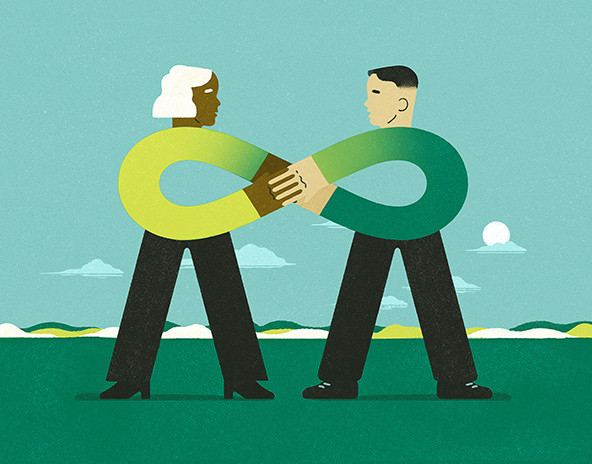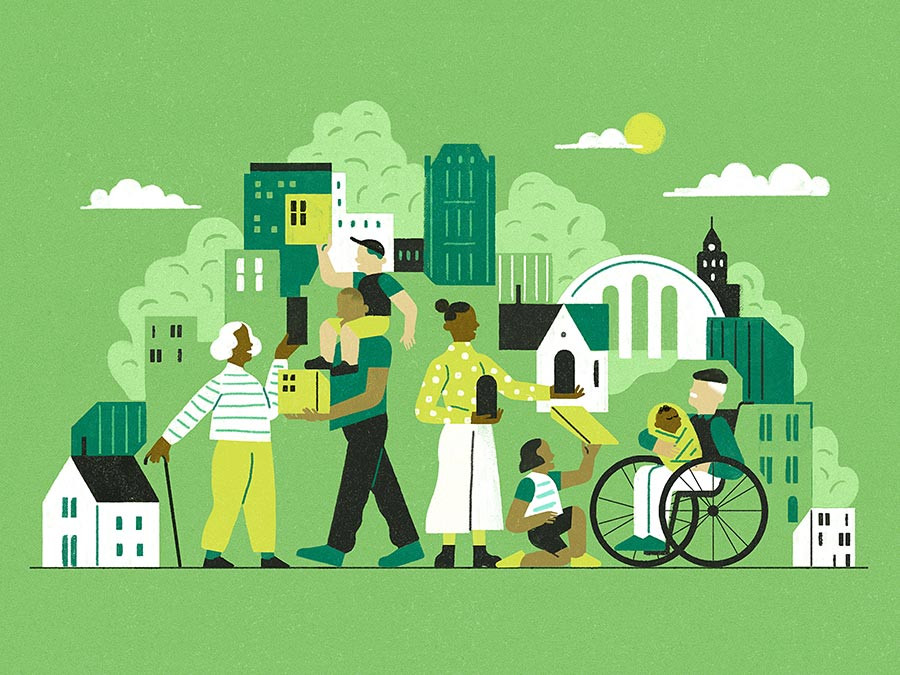 (Illustration by Gracia Lam)
(Illustration by Gracia Lam)
In the United States, age segregation is prevalent in national service, just as it is in housing, higher education, and community programs, and it limits opportunities for transformational social change we can ill afford to squander.
Ironically, 60 years ago Americans were poised to move in a different direction. As a United States Senator, John F. Kennedy declared that America was "wasting” the time, talent, and experience of older people—“resources of incalculable value." When he became president, he intended to end that waste. In his 1961 inaugural address, the 42-year-old Kennedy famously called his fellow Americans to civilian service. “Ask not what your country can do for you,” he challenged, “ask what you can do for your country.” The creation of the Peace Corps soon followed, and two years later, he called for a domestic service corps that would include both young people and older citizens.

President Kennedy's untimely death ended the dream of an intergenerational service corps. Instead, the nation established service efforts either explicitly or implicitly organized by age. Today, AmeriCorps VISTA, founded in 1965 as a domestic equivalent to the Peace Corps, enrolls mostly young people. The AmeriCorps Seniors Foster Grandparent program, established that same year, mobilizes low-income seniors in service. This pattern of age-tracking in service has continued over time, leading to parallel programs—AmeriCorps largely enrolling young people, AmeriCorps Seniors (formerly Senior Corps) exclusively recruiting older ones.
A Piecemeal Landscape
To be sure, many national service programs—which typically engage civilians in sustained, substantive, modestly paid service work at community-based organizations—involve cross-generational connection. The Foster Grandparent program’s 20,000 members, for example, work with disadvantaged and disabled children. And many AmeriCorps members serve older adults, helping with home repairs, providing transportation, and delivering meals. These efforts have demonstrated considerable mutual benefits, even when the service is formally directed either up or down the generational chain.
But co-generational service programs—which we define as national service efforts that deploy older and younger people to serve together—remain largely undeveloped. For a few years, the National and Community Service Act of 1990—aimed at expanding “full-time and part-time service opportunities for all citizens, particularly youth and older Americans”—gave rise to a bevy of creative and explicitly co-generational pilots, including the Delta Service Corps in Mississippi, Arkansas, and Louisiana, and the Urban Schools Service Corps in New Jersey. A quarter of Urban Schools Service Corps members were aged 50 and older, including many retired teachers and principals, who worked alongside younger adults in low-income school districts to improve students’ academic performance.
But today, while older and younger people often stumble into co-generational service—serving side by side in schools and food banks across the country, for example—it is more by happenstance than design. Only a few organizations intentionally engage both older and younger AmeriCorps members, and despite considerable advances in national service over the past 30 years (witness the growth of efforts like City Year and Teach For America) there is still nothing resembling Kennedy’s dream of a national service corps spanning the generations, in action together, to help solve problems facing communities and the country.
Making Co-Generational Service the Norm
The time is ripe to make co-generational service more deliberate and more widespread. As the introductory essay in this series notes, there are five generations alive at once, and a growing pool of available and experienced human capital. Studies show the distinct benefits that derive from older and younger people working collaboratively, including access to complementary skills, the potential for increased productivity, and the opportunity to bridge generational differences. What’s more, the American Rescue Plan Act of 2021 includes an investment of $1 billion in additional resources for enhancing national service over the next three years.
Here are four ways we can begin:
1. Make the Case
The road to age-integrating service begins with convincing policy makers, program operators, and potential investors that it is worth the effort.
This starts with demonstrating that the assets of older and younger people can fit together in powerful ways. For example, back in 2007, the automotive company BMW tested three assembly lines: one entirely of younger workers, another entirely of older workers, and a third combining the groups. The younger line was fast but error-prone. The elder line was accurate but slow. The co-generational line was both fast and accurate.
“Age diversity appears to boost productivity at the team level, likely because of ‘knowledge spillover,’” writes Heather Tinsley-Fix, a senior advisor at AARP, the largest US nonprofit focused on empowering older adults. “Team members share knowledge gained from past experiences, which in turn sparks new solutions to problems.” Research by the American Psychological Association also found that age diversity was positively associated with organizational performance.
Less studied, but perhaps more important, is the potential of age diversity—through proximity and shared purpose—to upend age stereotypes, fight loneliness, and bridge the divides of age, race, culture, and politics.
Steven Waldman—a journalist and author of the book The Bill, which describes the creation of AmeriCorps—argues that national service programs can reproduce the long-standing ability of military service to bring together people of varying backgrounds around a common mission. “Those in civilian service programs are not having rap sessions,” Waldman writes. “They’re putting on gloves, grabbing shovels, and working to help a town that’s been hit by flooding.”
2. Start With the Most Urgent Issues
Crises are often the impetus for innovation; they offer the chance to upend established practice, including age segregation in service.
Prompted by COVID-19, for example, Encore.org recently joined forces with AmeriCorps Seniors and California Volunteers, the state’s service commission, to launch the Encore Intergenerational Vaccine Corps. The initiative, now being piloted in Northern California, brings together retired medical personnel and non-medical volunteers of all ages, with the goal of vaccinating tens of thousands of underserved people. Retired doctors and other medical professionals administer vaccines and related care; older and younger lay volunteers work on non-medical tasks, including vaccination education efforts and community outreach; and full-time AmeriCorps members serve as volunteer coordinators. Beyond the crisis, other groups could potentially adapt the model to help meet additional urgent health needs.
Disaster relief has also proven fertile ground for co-generational service. SBP, a disaster preparation and recovery organization started in St. Bernard Parish after Hurricane Katrina, includes teams comprised of both older and younger AmeriCorps members. One participant, Sherylin Larkin, 66, moved to Puerto Rico to work as part of an age-integrated SBP and AmeriCorps team aiding recovery from Hurricanes Irma and Maria. “I’m learning all about social media from people in their 20s and 30s who are technology experts,” the former accountant explains. “I’m never treated differently or excluded from anything because of my age.”
3. Design for Forging Connections and Bridging Differences
It’s often not enough to have older and younger people enrolled in the same program. Those leading co-generational efforts need to think through everything from onboarding members to team meetings.
“Bridging difference should be an explicit goal of all national service programs,” says John Gomperts, a former director of AmeriCorps and later CEO of the youth-empowering association America’s Promise Alliance. “That means making sure that participants are diverse in all ways, that inclusivity is both valued and taught, and that there are clear opportunities for relationships to flourish and shared understanding to take hold.”
For example, Charlene Young, who is 69 and African American, and Jordan Fong, who is a recent University of the Pacific graduate and Asian American, are part of a multigenerational group of AmeriCorps literacy tutors with Reading Corps (part of the Stockton Service Corps in California). The program, which helps students in early grades master reading, placed Young and Fong in the same classroom, in close proximity. “Our desks were right next to each other,” says Young, who retired from the postal service in 2014 and taught her own children to read before they entered kindergarten. “I would overhear things, and if it seemed like he was having a problem with a student, I would interject,” she says. When the Reading Corps went virtual due to COVID-19, Young came to rely on Fong’s “techie” expertise during the transition to online tutoring. In the process, the two became friends, forging bonds not just across age but culture. “We just clicked,” says Young. “We help each other out.”
4. Invest in Innovation
National service has benefited throughout its history from the support of philanthropy, government, and the social innovation field. Now all three must commit to generating new ways of undertaking, evaluating, and advancing co-generational service.
Foundations could use tactics such as a prize for surfacing existing innovations that might fall below the radar screen, as well as incentive grants to encourage new models in schools, housing, higher education, and community organizations. Funders such as The Eisner Foundation and RRF Foundation for Aging are already doing this in various ways, but investment from the broader foundation field remains far short of the need and opportunity.
Government has an equally important role to play, namely in age-integrating programs like AmeriCorps, where only 5.4 percent of participants are over 50. One way to do this is by bringing together the work of AmeriCorps and AmeriCorps Seniors in hundreds of locations where programs co-exist and frequently work on similar challenges. Innovations might involve joint, co-generational service projects, and shared training and support for making the most of the service experience.
Social innovation organizations can also chart new paths, as Ashoka is beginning to do. The organization’s Next Now initiative is bringing together social entrepreneurs focused on aging and intergenerational innovation (as well as areas like climate and gender issues) to learn from each other and advance social innovation in the context of longevity. Programs like these can do much to elevate the profile of intergenerational solutions, attract talent to this field, and help prepare entrepreneurs for success.
Ask Now, Act Together
Six decades after Americans elected the youngest president in history, the United States inaugurated its oldest commander in chief, Joe Biden. The youngest president saw the potential power of bringing generations together to serve community and country. The oldest president has an opportunity to help realize it.
President Biden, 78, got a good start on Inauguration Day when he shared the limelight with 24-year-old poet Amanda Gorman. Gorman articulated the essence of a co-generational, racially and culturally diverse call to action by saying, "We close the divide because we know, to put our future first, we must first put our differences aside. ... So let us leave behind a country better than the one we were left with."
Truly realizing this promise will require a national service effort that enlists and embraces people of all ages and backgrounds, and brings them together to create a better future for all generations.
Support SSIR’s coverage of cross-sector solutions to global challenges.
Help us further the reach of innovative ideas. Donate today.
Read more stories by Phyllis Segal & Marc Freedman.

